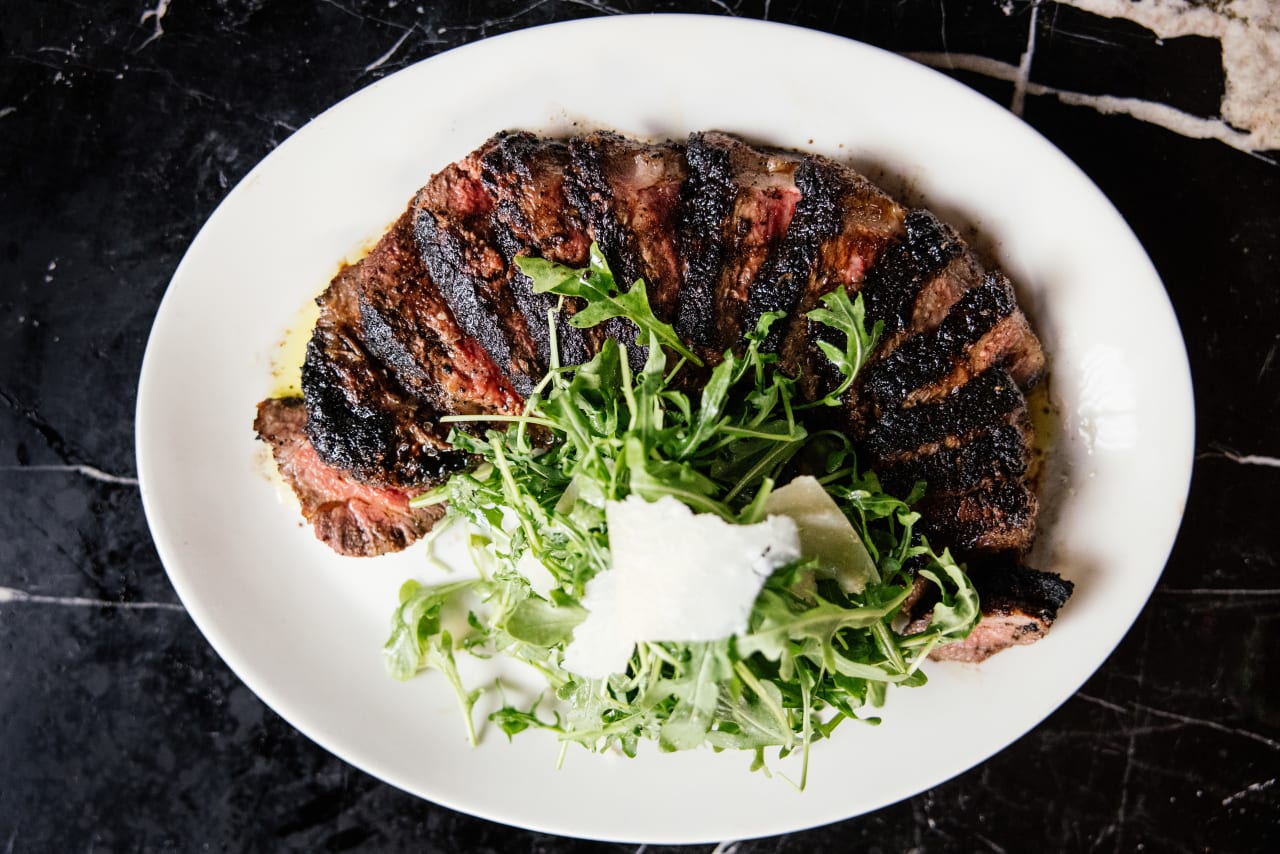
Nancy Silverton's Grilled Wagyu Tagliata

Nancy Silverton
Nancy Silverton
Legendary chef, baker and author Nancy Silverton was winner of the James Beard Foundation's Outstanding Chef Award in 2014. A true culinary icon, she was lauded for her pastry work at Spago and Campanile and brought sourdough baking to new attention at La Brea Bakery. She is now chef and co-owner of the Mozza Restaurant Group. “With all the food we do, no matter how simple it is, the flavours are always layered,” she says. “With meat, we start with a high quality product and make sure it’s well seasoned. We want people to walk away and be satisfied.”
Tagliata is an Italian classic, a salad with sliced steak, rocket (arugula) and Parmigiano Reggiano, built element by element into a shareable crowd-pleaser.
“With all the food we do, no matter how simple it is, the flavours are always layered,” says Nancy Silverton. “This is a great example that relies on starting with a high quality product - the Wagyu - and complementing it with supporting elements that are similarly high quality.”
For her version, the steak is marinated in rosemary and balsamic vinegar. “It’s a really simple marinade that has a sweet note but not one that drowns out the flavour of the meat,” says Nancy.

Ingredients
Grilled Wagyu Tagliata
Grilled Wagyu Tagliata
1 cup balsamic vinegar
½ cup whole fresh rosemary needles
8 whole garlic cloves
½ cup extra virgin olive oil
1 Westholme coulotte (also called rump cap or picanha) or use sirloin
kosher salt
freshly ground black pepper
115 g (4 oz) wedge Parmigiano Reggiano
8 cups loosely packed rocket (arugula), preferably wild
Lemon Vinaigrette (see below)
Maldon or other flaky salt
aged balsamico condimento
finishing quality olive oil
Lemon Vinaigrette (makes 1 cup)
Lemon Vinaigrette (makes 1 cup)
¼ cup minced shallots
¼ cup lemon juice
1 tbsp Champagne vinegar
1 tsp kosher salt, plus more to taste
½ cup extra-virgin olive oil
½ tsp freshly ground black pepper, plus more to taste
Method

Grilled Wagyu Tagliata
Combine the balsamic vinegar, rosemary and garlic in a food processor fitted with a metal blade or the jar of a blender. Pulse until the rosemary is finely chopped. Add the olive oil and pulse until all the ingredients are combined.
Remove the silver skin from the coulotte and cut into two long, narrow pieces. Place the steaks in a large bowl or nonreactive baking dish. Pour the marinade over and turn to coat on all sides. Cover tightly with plastic wrap and refrigerate for at least 1 hour and up to overnight. Remove the steaks from the refrigerator and bring them to room temperature before grilling.
Prepare a hot fire in a gas or charcoal grill or preheat a grill pan or heavy-bottomed skillet over high heat.
Remove the steaks from the marinade, discard the marinade, and generously season the steaks with salt and pepper on both sides, using about 1 tsp of salt per 450 g / 1 lb meat.
Put the steaks on the grill or grill pan and cook until the meat is seared and deep brown on all sides, 5 to 6 minutes per side for medium rare. Remove the steaks to a platter or cutting board and let them rest for about 5 minutes before slicing. Use a sharp knife to carve the steaks diagonally against the grain into 1.2 cm / ½ in. thick slices.
While steaks are resting, use a large knife or mandoline to cut the Parmigiano Reggiano into very thin slices. Put the rocket (arugula) in a large, wide bowl, sprinkle with salt and toss gently to distribute evenly. Drizzle with the Lemon Vinaigrette (see below) and toss gently to coat the leaves. Taste for seasoning and add more salt or vinaigrette if desired.
Slide a long knife under one quarter of the steak slices and transfer to a dinner plate, gently fanning out the slices in a slightly curved line. Repeat, fanning the remaining slices on the other plates and drizzle with any juices that have collected on the cutting board. Lay a few slices of Parmigiano Reggiano next to each serving, in the space left by the curved line of the meat. Building the salad in two layers from here and saving the largest cheese slices for the top, pile a handful of arugula on each bed of cheese. Place another layer of Parmigiano Reggiano slices on the rocket and top it with another handful of rocket. Lay the largest slices of Parmigiano Reggiano on the finished salads. Sprinkle each serving of steak with a pinch of sea salt, drizzle each with 1 tsp of balsamico condimento and finishing quality olive oil. Serve.
Lemon Vinaigrette
Combine shallots, lemon juice, vinegar and salt in a small bowl. Set the bowl aside for 5 to 10 minutes to marinate the shallots.
Add the olive oil in a slow, steady stream, whisking constantly to combine. Stir in the pepper. Taste for seasoning and add more salt or pepper, if desired.

“With all the food we do, no matter how simple it is, the flavours are always layered,” says Nancy Silverton. “This is a great example that relies on starting with a high quality product - the Wagyu - and complementing it with supporting elements that are similarly high quality.”


